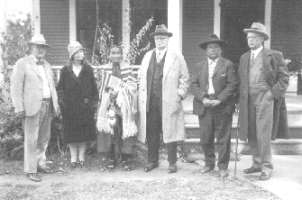|
Peace Treaty |
||
© 1996, 1997,1998, 1999, 2000 Cyber Lodge Internet Services. All rights reserved. Any copying, redistribution or retransmission of any of the contents of this service without the express written consent of Cyber Lodge Internet Services is expressly prohibited.
|
Peace Treaty: The product of a town working together
1927 Pageant Dignitaries The Formation of The Medicine Lodge Indian Peace Council Treaty Memorial Association In 1926, the newly formed Medicine Lodge Indian Peace Council Treaty Memorial Association invited Kiowa Chief I-See-O to Medicine Lodge to locate the exact spot of the signing of the 1867 Peace Treaty. I-See-O was 18 years old at the time of the Medicine Lodge Peace council. He located the exact spot where the treaties were signed, one-fourth to one-half mile south of Medicine Lodge just below where the Medicine River and Elm Creek intersect. Thus began plans for the first ever Medicine Lodge Indian Peace Treaty Pageant. In August of 1926, just a little over a year before the pageant was to take place, the Association elected its first officers and directors. Among those elected were Mrs.. George Hibbard, John C. Best, Samuel Griffin, Joseph C. Hinshaw, Frank B. Chapin, Sallie Woodward, J. Fueller Groom, Rachel Ann Nixon, George Hunt and Lillian Hunt. Mr. Best, owner of The Gypsum Company, was the first president of the Association. After the spring of 1926, news of progress on the pageant plans were published in the Barber County Index nearly every week. It was at this time that the citizens of Medicine Lodge really began to delve into the rich history of the area. The Index began printing old eye-witness accounts of the Peace Council by authors such as ex-Tennessee Governor Alfred A. Taylor and correspondents from the New York Tribune. The Association found the exact boundaries of the old Indian stockade, which was the first step in building the historic Stockade Museum. They also commissioned a monument to be built to commemorate the Peace Council. That monument now stands on the northeast corner of First and Main Street, and has been there for 67 years. Surprisingly, the Associationís organization that first year was very much like it is today. Many of the committees were the same, such as the advertising committee and the Indian committee. The Lionís Club, which had only been chartered in Medicine Lodge for a year, sponsored the trip to Medicine Lodge for 250 Indians from the Comanche, Kiowa, Prairie Apache, Arapaho and Cheyenne for the pageant. The city had to provide a place for the Indians to camp. This was the beginning of the Indian Village that attracts tourists every Peace Treaty. The advertising committee printed 100,000 stickers that first year. The stickers were sold strictly at cost ($2.00 per thousand) to local businesses so they could send them out in their daily mail. The committee also purchased car banners and made sure all cars in town had one, especially those that were going to be traveling out of town. Window stickers were purchased, and every car that showed up in Medicine Lodge, left with a Peace Treaty sticker on its windshield. There were a few difficulties along the way in planning the celebration. The city applied for a government appropriation to pay for the Peace Treaty monument, and was turned down. But this didnít stop the citizens of Medicine Lodge. The Association asked for donations from town businesses and organizations to build the monument. As time neared for the first Indian Peace Treaty Pageant (held on Oct. 12-14, 1927) the citizens of Medicine Lodge became more involved in preparations for the celebration. The pageant, which was written and directed by Professor F.L. Gilson of the State Teacherís College at Emporia, required the participation of nearly every man, woman and child in town. Index Editor and Owner J.C. Hinshaw described the townís excitement by saying, "As time nears, it is evident that everybody in Medicine Lodge and surrounding country will be afire with enthusiasm concerning the celebration." On Sept. 29, 1927, Editor Hinshaw printed the first ever Peace Treaty Special Edition. Though long before modern technology, Hinshaw managed to publish a 32 page edition and had to turn some advertisers away. There and then, he set a precedent that is still being followed today. By DeDe Morgan-Vick, The Gyp Hill Premiere, 1994 |
|


